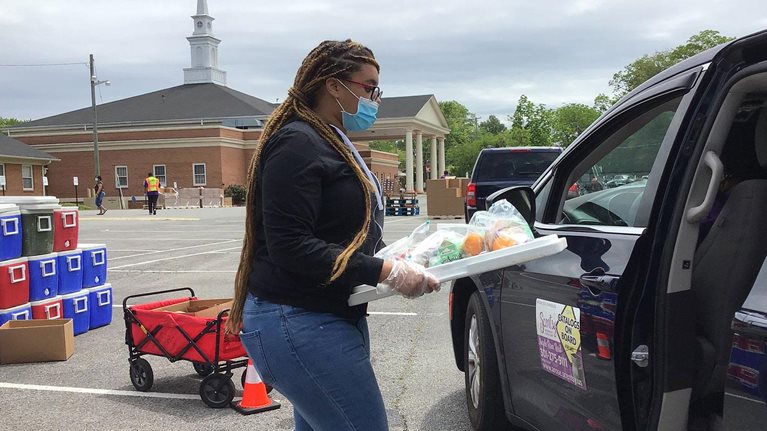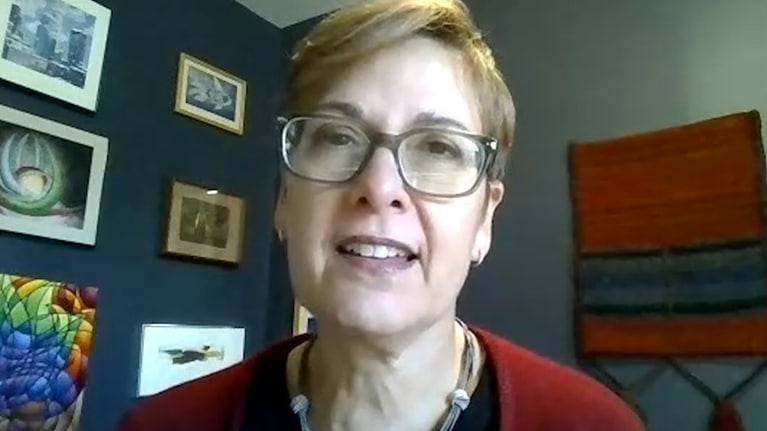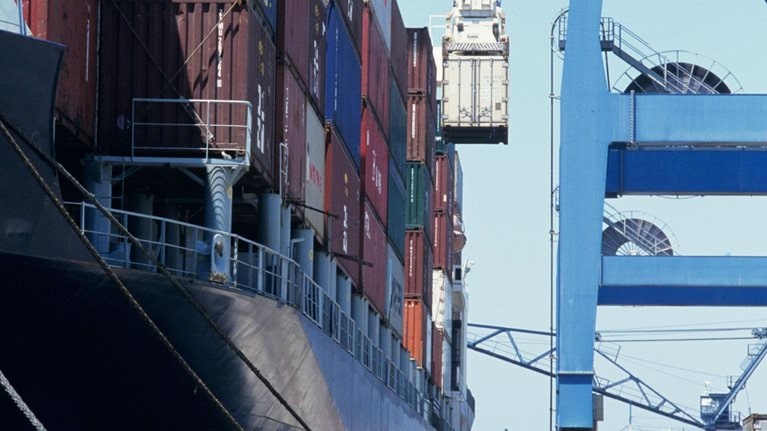Heading into 2021, food banks knew tough times could be getting tougher.
Despite lowered forecasts due to significant government intervention and generous contributions from individuals, corporations, foundations, and communities to the charitable food system, an estimated 40 million Americans may continue to face hunger in 2021. The lingering effects of the pandemic—including unemployment and poverty rates—have sustained a continued upsurge in demand for food banks.
Food banks have new experience operating under emergency conditions, including finding new sources of food to replace donations impacted by supply-chain disruptions at the onset of the pandemic. They have developed safer ways to distribute food to people who need it, while managing risks to volunteers and clients. They are also using a forecasting model developed by Feeding America, the nation’s largest food bank network, to predict the effect of varying economic conditions on the demand for food in their area.
Prepandemic, Feeding America estimated that approximately 35 million people in America faced hunger; this rose to an estimated 45 million during the pandemic. Food banks’ use of data and analytics helped them react to unprecedented demand and uncertainty. Forward-looking scenarios of supply (where food banks would receive donations from) and demand (where need would come from) helped food banks understand the potential need for food based on the trajectory of virus cases, unemployment rates, and government interventions such as the Coronavirus Food Assistance Program (CFAP). Heightened awareness of food insecurity has increased outreach and donations, which means clearly articulating the need is critical to translating that goodwill into action in the height of the crisis and in the future.
“Food banks have never had so much attention as we do now; there’s so much awareness of hunger,” said Kristen Miale, president of Good Shepherd Food Bank of Maine. “But the majority of people we serve, we were serving before COVID-19. We can’t forget about this when we’re on the other side [of the pandemic].”
Using lessons learned to plan for the next normal
Food banks are taking what they learned in 2020 to improve operations, engage new types of expertise, and shape new roles focused on leveraging real-time data, expanding their network of community partners to distribute food and other aid, and partnering with local governments and potential donors—all while leveraging more granular, data-driven insights.
Many of those improvements stem from food banks’ increased use of analytics during the pandemic to better forecast demand for food aid and better source food donations. Among these forecasting tools were models created by Feeding America, with assistance from McKinsey, to help the 200 food banks within its network understand the effects of unemployment and other economic trends in shaping the outlook for the food-insecure population.
Feeding America’s quantitative model analyzed multiple economic and epidemiological variables, including county-level unemployment rates, poverty levels, jobs at risk (projected by McKinsey), and scenarios based on future COVID-19 caseloads. Using these layers of data, the model was able to project multiple scenarios for the pandemic’s effect on food insecurity in the United States. To determine supply, the model used data and analytics to analyze real-time supply data within the Feeding America network, while tracking the likely impact of emergency federal aid programs such as CFAP that impact the volume of commodity products distributed from the government to food banks. To empower local agencies to make more informed decisions, Feeding America created a separate tool for member food banks to rapidly replicate the demand and supply analysis with assumptions that could be customized for a specific geographic area.
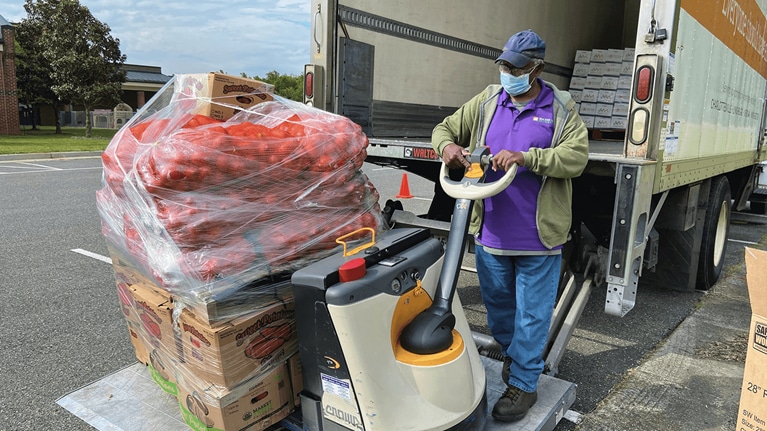
Food banks are free to use the models as they see fit. Some used the demand data and plugged in their own supply assumptions, according to Angela Gallagher, Feeding America program evaluation manager, who worked on the project. Others asked Feeding America to help them analyze demand at the county or subcounty level in order to identify specific needs at a very granular level.
“It gave us a process,” Miale said of the forecasting tools.
Would you like to learn more about our work on Food Security?
Good Shepherd Food Bank used the Feeding America model as a starting place to determine how the pandemic could impact demand within the specific demographic segments it serves, such as school children and rural residents. “Breaking the demand metrics down into pieces made it easier to answer than trying to solve how much food we would need [overall],” Miale said.
Leaders at Good Shepherd knew that prior to the pandemic, the food bank met about 78 percent of the total need for food aid in Maine. Using new projections based on the Feeding America model, they projected total need would grow by 25 percent. This would entail providing eight million to ten million more meals than they had before the pandemic to meet demand. They also used the model to understand how demand would change if more Maine residents signed up for public assistance, if local employment increased, or if the Coronavirus Aid, Relief, and Economic Security (CARES) Act was extended (which it has been, through September 2021).
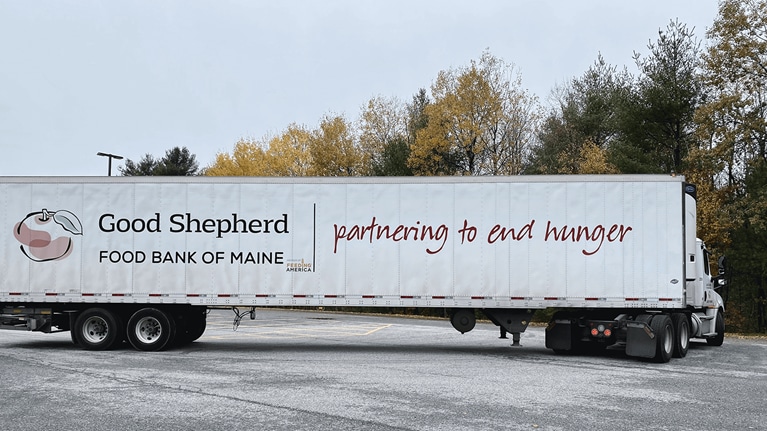
From there, Good Shepherd used the analytics to determine how the supply of food available through specific channels—including the US Department of Agriculture’s Farmers to Families Food Box program, other federal aid, and donated food—could affect how much food the food bank might need to purchase.
As the year played out, the food bank received more donated food than expected and more financial donations it could use to buy food, erasing concerns that it might not meet demand. In fact, it had so much food that the organization leased a third warehouse just to store it all. “We went from thinking food supply would be our biggest constraint to the biggest bottleneck being our agencies’ capacity to store and distribute all the food we sourced,” Miale said.
Good Shepherd’s efforts to increase capacity were met with an unexpected gift. In late December, the organization learned that it was one of 42 US food banks (and 384 nonprofits overall) to receive a surprise donation from MacKenzie Scott, billionaire philanthropist, author, and cofounder of Amazon with her ex-husband, Jeff Bezos. Good Shepherd will incorporate the $25 million gift into a larger fundraising campaign that began in January. The food bank plans to devote the largest portion of the gift to helping its food distribution partners address their own capacity issues. Good Shepherd began helping partners expand last year, awarding them grants to purchase additional cold storage and gas cards for volunteers making home deliveries.
Scott’s donation will also help Good Shepherd grow its staff, including adding a position devoted to food sourcing and cultivating new food donors, working on long-term projects, “and looking at sourcing in a strategic way,” Miale said. The food bank will also use funds for internal capacity building and advocacy, and to fund its endowment and a related nonprofit food venture.
The work that Good Shepherd put into forecasting demand and supply in 2020 laid the groundwork for some of the new initiatives, including creating a long-term plan for food sourcing.
How other food banks are planning for 2021
Other food banks are using the experiences of 2020 to plan for 2021 and beyond.
Second Harvest Heartland in Minnesota built its own forward-looking demand- and supply-forecasting tools in the heat of the crisis. According to Thierry Ibri, chief operations and programs officer at the food bank, the more the leaders used the tools, the more predictive and useful they became. “With the economy not rebounding as quickly as expected, the food bank continues to update the models and is now using them to continue forecasting need for the next three years,” Ibri said.
At Second Harvest Heartland, the learnings from 2020 went far beyond a set of tools. The food bank has also hired a dedicated analyst to own the demand-planning process; instituted regular, rigorous data reviews; and continued to share insights with agency partners in expanded, joint-planning processes. Second Harvest Heartland serves about 275,000 people in 41 counties in Minnesota and 18 in western Wisconsin.
During the pandemic, Capital Area Food Bank, which operates in and around Washington, DC, witnessed a 50 percent increase in the number of people needing food assistance. The food bank used the situation to reconfigure its distribution system to improve coverage, and to continue prepandemic efforts to expand offerings from food aid alone to “food+” programs, which pair food with additional basic support services, such as financial counseling, to address root causes of hunger. That has included identifying community partners that could help provide food bank patrons with job training, healthcare, and signing up for public assistance.
“Capital Area Food Bank is likely to be working in pandemic-response mode for many months to come,” according to the food bank’s CEO, Radha Muthiah. Meanwhile, as the economy picks up, the food bank is “sowing little seeds” to start growing recovery efforts.
“As the region starts thinking about rebuilding, we have to make sure we include everyone. Through food, education and skill building, and better health and wellness, they can be part of this growth,” Muthiah said. To accommodate this, the food bank shifted to a longer, 12- to 18-month planning cycle, which will give staff better insights on the scale of revenue and expenses associated with those activities.
